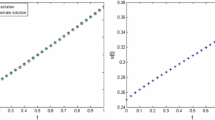Abstract
We solve a logistic differential equation for generalized proportional Caputo fractional derivative. The solution is found as a fractional power series. The coefficients of that power series are related to the Euler polynomials and Euler numbers as well as to the sequence of Euler’s fractional numbers recently introduced. Some numerical approximations are presented to show the good approximations obtained by truncating the fractional power series. This generalizes previous cases including the Caputo fractional logistic differential equation and Euler’s numbers.
Similar content being viewed by others
1 Introduction
The logistic ordinary differential equation \(u'(t)=u(t)\cdot [1-u(t)]\) appears in many contexts and have different applications in physics [3, 8, 9, 11], medicine [17], economy [16], and even to study the evolution of the COVID-19 epidemic [13, 14].
The solution, for a given initial condition \(u(0)=u_0,\) is
For \(u_0=1/2 , \) we have the classical logistic function
Different versions and generalizations of the logistic equation have been considered and, in particular, the fractional versions of the logistic differential equation [2,3,4,5, 12, 15].
For example, a fractional version has been studied:
with \(\alpha \in (0,1)\) and \(D^{\alpha }\) the Caputo fractional derivative [7]. Although an analytical expression for the solutions is not known, it has been solved using different techniques such Euler’s numbers [4, 6], implicit solutions [10] or fractional power series [3].
We study a new generalization of the fractional differential equation (1.1) that includes as a particular case the Caputo fractional logistic differential equation.
Moreover, we use fractional generalized proportional derivative having a singular kernel.
We introduce a novel class of Euler’s numbers, the generalized proportional fractional Euler numbers. We recall that Euler’s polynomials and Euler’s numbers are related to the Riemann’s zeta function and to the logistic function [3]. The relevance is apparent due to the importance of solving the famous Riemann Hypotheses.
This paper is organized as follows. In the next section we introduce the generalized proportional fractional calculus with its basic concepts and properties. Then, it is solved a simple linear fractional differential equations to motivate our technique in order to solve a generalized fractional logistic differential equation. Finally in the last section, we present the generalized proportional fractional Euler’s numbers. Euler’s numbers appear in connection to the most important function in mathematics: the zeta function.
2 Generalized proportional calculus
Let \(T >0,\) \(\alpha >0\) be the order of the fractional integral and \(\rho \in (0,1]\) be the proportion. For a function \(u \in L^1(0,T)\) we define the generalized proportional integral of the function u as
The corresponding Caputo generalized proportional fractional derivative for a function \(u \in L^1(0,T)\) such that \(u \in AC[0,T]\) is defined as [1]
where
We note that for \(\rho =1\) we obtain the classical Caputo fractional derivative [7]:
We recall that [1]
Also, for \(\beta >0\), consider the function
then
We now study some differential equations under this generalized fractional calculus. Indeed, consider the nonlinear differential equation of the type
with the initial condition
Here \(f:[0,T]\times \mathbf{{ R}} \rightarrow \mathbf{{R}}\) is a nonlinear function satisfying appropriate conditions.
3 Linear generalized proportional differential equations
Let \(\sigma \in L^1(0,T)\) so that the corresponding generalized proportional integral of \(\sigma \) exists.
We begin with the simple case
By applying the generalized proportional fractional integral, we have
Therefore,
Now, for \(\lambda \in \mathbf{R}\), let us study the following linear differential equation
The solution is known [1]
where \(\mathcal{{E}}_{\alpha }\) is the classical Mittag-Leffler function defined for any \(z \in \mathbf{{C}}\) as
We now re-obtain this solution as a fractional power series. Moreover, this will serve as a clear introduction to our methodology. Indeed, take \(r=\frac{\rho -1}{\rho }\) and let us assume that the solution is given formally as the following fractional power series
Thus, formally,
and
Equivalently,
Identifying the coefficients, we get \(a_0 = u_0\) and the recurrence formula
This implies that
so that
See Fig. 1. For \(\rho =1\), that is \(r=0\) we have the classical fractional Caputo equation
whose solution is indeed given by
Solutions of the linear generalized proportional fractional differential equations (3.1) with \(\lambda =1\) for the initial condition \(x_0= 1/2\) and \(\alpha =1/2\). For \(\rho =1/2\) in blue. For \(\rho =1\) the Caputo fractional differential equation (3.2) in the middle (orange) and the classical logistic function below (green)
4 Logistic generalized proportional differential equations
We now consider a logistic-type equation corresponding to the nonlinear equation (2.1) with
where \(\lambda , \, \mu \in R\) and \(r= \frac{\rho -1}{\rho } \, ,\) that is, the logistic fractional generalized proportional differential equation
For \(\mu =0\) we have the previous linear equation (3.1).
In the case \(\rho =1\), that is, \(r=0\), we obtain the following Caputo fractional logistic differential equation
that has been solved recently [3].
As for the linear situation, we assume that
Then, using the Cauchy product we get
Therefore,
Identifying the coefficients corresponding to the powers of \(t^\alpha \) , we get
and for \(n \ge 1\), the recurrence relation
or
Taking the initial condition \(u(0)=1/2\) so that \(a_0 = 1/2.\) Thus, for example,
and
For example, for \(\alpha =1/2\), \(\rho =1/4\) and \(\lambda =\mu =1\) we have the following values of \(a_n(1/2,1/4)\) for \(n=0,1,\dots ,15\) (See Fig. 2)
The solution of the classical ordinary differential equation
with the initial condition
is the logistic function
In this case, \(\rho =1 \, , \, \, \alpha =1 \, , \, \, \lambda = \mu =1\) and the recurrence relation is
The solution of new the logistic equation (4.1) is given by (4.2) and can be approximated by (See Fig. 3)
Approximate solution \(p_m(t) \, , \, \, m=10 ,\) of the logistic generalized proportional fractional differential equations (4.1) for the initial condition \(x_0= 1/2\) and \(\alpha =1/2\). For \(\rho =1/2\) in blue. For \(\rho =1\) the corresponding approximate solution \(p_{10}(t)\) of the Caputo fractional logistic differential equation (3.2) (orange) and the classical logistic function below (green)
5 Generalized proportional Euler numbers
We recall the Euler polynomials defined as
Taking \(x=1\) we derive
where
This logistic function is the solution of the logistic problem
It is well-known that the coefficients \(a_n\) are related to the Euler numbers \(E_n\) by
For a given \(a_0 \in R\) and in view of (4.3), we define the generalized proportional fractional Euler numbers by the recurrence relation
For \(\lambda =\mu =1\) we denote \(a_n(\alpha ,\rho )=a_n(\alpha ,\rho ,1,1)\). If in addition \(\rho =1\) then \(a_n(\alpha )=a_n(\alpha ,1).\)
Obviously,
Also,
where
are the Euler fractional numbers introduced in [12] and studied in [3].
We therefore have generalized the Euler numbers \(E_n\) and the Euler fractional numbers \(E_n^{\alpha }\) to the generalized proportional Euler’s fractional numbers
6 Conclusions
We have introduced a new generalization of the fractional logistic differential equation. To find an explicit solution as a fractional power series, one is lead to the corresponding general fractional Euler’s numbers.
Some figures are plotted to illustrate the results in order to compare the solutions of the classical logistic equation, of the Caputo fractional logistic differential equations and the new generalized proportional fractional logistic differential equation.
References
Agarwal, R., Hristova, S., O’Regan, D.: Stability of generalized proportional Caputo fractional differential equations by Lyapunov functions. Fractal Fract. 6, 34 (2022)
Area, I., Nieto, J.J.: Fractional-order logistic differential equation with Mittag-Leffler-type kernel. Fractal Fract. 5, 273 (2021)
Area, I., Nieto, J.J.: Power series solution of the fractional logistic equation. Physica A 573, 125947 (2021)
Balzott, C., D’Ovidio, M., Loreti, P.: Fractional SIS epidemic models. Fractal Fract. 4, 44 (2020)
El-Sayed, A.M.A., El-Mesiry, A.E.M., El-Saka, H.A.A.: On the fractional-order logistic equations. Appl. Math. Lett. 20, 817–823 (2007)
Kaharuddin, L.N., Phang, C., Jamaian, S.S.: Solution to the fractional logistic equation by modified Eulerian numbers. Eur. Phys. J. Plus 135, 229 (2020)
Kilbas, A.A., Srivastava, H.M., Trujillo, J.J.: Theory and Applications of the Fractional Differential Equations. North Holland, North-Holland Mathematics Studies (2006)
Leonel, E.D.: The Logistic-like map. In: Scaling Laws in Dynamical Systems. Nonlinear Physical Science. Springer, Singapore, 45-55 (2021)
do Nascimento, J.D., Damasceno, R.L.C., de Oliveira, G.L.: Quantum-chaotic key distribution in optical networks: from secrecy to implementation with logistic map. Quantum Inf. Process. 17, 329 (2018)
Nieto, J.J.: Solution of a fractional logistic ordinary differential equation. Appl. Math. Letters 123, 107568 (2022)
Sun, J.W.: Asymptotic profiles in diffusive logistic equations. Zeitschrift für Angewandte Mathematik und Physik. 72, 152 (2021)
D’Ovidio, M., Loreti, P.: Solutions of fractional logistic equations by Euler’s numbers. Physica A 506, 1081–1092 (2018)
Pelinovsky, E., Kurkin, A., Kurkina, O., Kokoulina, M., Epifanova, A.: Logistic equation and COVID-19. Chaos Solitons Fractals 140, 110241 (2020)
Saito, T.: A logistic curve in the SIR model and its application to deaths by COVID-19 in Japan. MedRxiv, https://doi.org/10.1101/2020.06.25.20139865
Tarasov, V.: Exact solutions of Bernoulli and logistic fractional differential equations with power law coefficients. Mathematics 8, 2231 (2020)
Tarasova, V.V., Tarasov, V.: Logistic map with memory from economic model. Chaos Solitons Fractals 95, 84–91 (2017)
Valentim, C.A., Jr., Oliveira, N.A., Rabi, J.A., David, S.A.: Can fractional calculus help improve tumor growth models? J. Comput. Appl. Math. 379, 112964 (2020)
Acknowledgements
This work has been partially supported by the Agencia Estatal de Investigación (AEI) of Spain under Grant PID2020-113275GB-I00, cofinanced by the European Community fund FEDER, as well as Xunta de Galicia grant ED431C 2019/02 for Competitive Reference Research Groups (2019-22).
Funding
Open Access funding provided thanks to the CRUE-CSIC agreement with Springer Nature.
Author information
Authors and Affiliations
Corresponding author
Ethics declarations
Conflict of interest
The author declares that he has no known competing financial interests or personal relationships that could have appeared to influence the work reported in this paper.
Additional information
Publisher's Note
Springer Nature remains neutral with regard to jurisdictional claims in published maps and institutional affiliations.
Rights and permissions
This article is published under an open access license. Please check the 'Copyright Information' section either on this page or in the PDF for details of this license and what re-use is permitted. If your intended use exceeds what is permitted by the license or if you are unable to locate the licence and re-use information, please contact the Rights and Permissions team.
About this article
Cite this article
Nieto, J.J. Fractional Euler numbers and generalized proportional fractional logistic differential equation. Fract Calc Appl Anal 25, 876–886 (2022). https://doi.org/10.1007/s13540-022-00044-0
Received:
Revised:
Accepted:
Published:
Issue Date:
DOI: https://doi.org/10.1007/s13540-022-00044-0
Keywords
- Logistic differential equation
- Fractional calculus
- Generalized proportional fractional integral
- Euler numbers
- Euler fractional numbers







